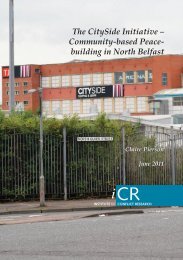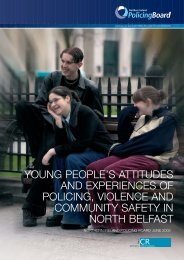Young People and Interfaces Report - Institute for Conflict Research
Young People and Interfaces Report - Institute for Conflict Research
Young People and Interfaces Report - Institute for Conflict Research
Create successful ePaper yourself
Turn your PDF publications into a flip-book with our unique Google optimized e-Paper software.
YOUNG PEOPLE AND INTERFACES<br />
• The first model focuses on adult-led processes. This method allows young people to be invited to<br />
events <strong>and</strong> share their views <strong>and</strong> experiences. However, the report argued that this in <strong>and</strong> of<br />
itself does not lead to the empowerment of young people as it is predicated upon consultation<br />
rather than participation;<br />
• The second model focuses on adult-initiated processes. While adults develop a project or<br />
process of dialogue, young people are invited to have some control over the inputs <strong>and</strong> outcomes<br />
of the discussion. As such they are not merely responding to an adult agenda <strong>and</strong> are allowed the<br />
space to shape the questions they would like answered; <strong>and</strong><br />
• The third <strong>and</strong> final model of engagement focuses on youth-led processes. This involves young<br />
people themselves identifying the issues of primary concern <strong>and</strong> taking resultant action. This may<br />
involve the establishment of youth <strong>for</strong>ums to campaign on specific issues. One challenge with<br />
such developments is that they tend to limit the engagement to a small number of committed<br />
young people, <strong>and</strong> this can become dominated by the most articulate <strong>and</strong> exclude those on the<br />
margins. 26<br />
It is clear that in line with the Programme <strong>for</strong> Government, young people who live in interface areas<br />
should be part of the area based action plan discussions on developments at the interface,<br />
including any potential changes to security architecture. But effective consultation <strong>and</strong> engagement<br />
with young people needs to allow space <strong>for</strong> them to ask questions they feel are relevant (within<br />
reason) rather than simply being told of developments which are happening <strong>and</strong> why they are<br />
happening.<br />
While a youth led process in terms of discussion on interface issues is likely to be impractical,<br />
certainly an adult initiated process in which young people have the opportunity to explore issues or<br />
concerns they have regarding the interface would be an appropriate process of dialogue which the<br />
CRC <strong>and</strong> ICP could help facilitate. Such a consultation process may involve three core elements:<br />
1. An initial process of in<strong>for</strong>mation sharing with young people. The UN report suggests that young<br />
people at all times need adequate in<strong>for</strong>mation about the issues at h<strong>and</strong> in order <strong>for</strong> them to<br />
make a meaningful contribution to consultation. The ICP are well placed to work with young<br />
people in their areas, through schools, church groups, sports clubs, educational organisations,<br />
local youth organisations <strong>and</strong> youth clubs, to in<strong>for</strong>m young people about developments at the<br />
interface;<br />
2. Space should be provided <strong>for</strong> young people within an interface community to discuss their views<br />
on interface issues in a safe environment. Initially this may take place amongst young people<br />
be<strong>for</strong>e potentially including young representatives in an inter-generational discussion with adults;<br />
3. <strong>Young</strong> people from across the interface should be brought together to share their views on any<br />
potential developments. These discussions may only include young people, or rather include<br />
young people with adults in a cross-interface discussion. Relevant stakeholders should decide<br />
which is the most appropriate means of engagement. It may be useful <strong>for</strong> members of statutory<br />
organisations such as DoJ to be in attendance to discuss future plans.<br />
26 All three models of engagement with young people follow the principle of the United Nations Convention on the Rights of the Child which states that<br />
young people under the age of 18 have the right to participate in decision-making.<br />
28






